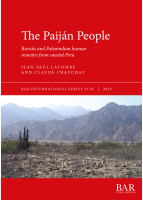Description
From 1972 to 1997, archaeological research was undertaken on open air early sites on the north coast of Peru (Cupisnique region: about 7°30 south latitude). These sites contained lithic tools and faunal remains belonging to the Paiján tradition, dating from around 13000 to around 8000 cal BP. In this desert space between the Pacific Ocean and the Andes, superficial sites contained knapped lithics (projectile points and ordinary tools on flakes) and microfaunal remains such as land snails, fish and lizards. After discovering human remains eroding out of the surface, a French-Peruvian team including archaeologist Claude Chauchat and bio-anthropologist Jean-Paul Lacombe excavated a total of 19 burials associated with this Paiján tradition. This book presents a detailed description of these remains, yielding information about these foragers’ physical constitution as well as their lifestyle. These remains are also compared with several other populations from coastal Peru, remains from the highland caves, and other findings from South and north America dating from the Pleistocene - Holocene transition.
AUTHOR
Jean-Paul Lacombe, a medical doctor, archaeoanthropologist and human ecology graduate, has worked since 1973 in the laboratory of Prof. Dr. R. Riquet (Bordeaux University), subsequently directed by Prof. B. Vandermeersch. He participated in and co-directed the excavation of Paiján burials between 1984 and 1990 and defended his thesis in biological anthropology of the Paiján people in 2000.
Claude Chauchat, now a retired CNRS researcher, first worked on Palaeolithic France in the laboratory of Professor F. Bordes' laboratory. From 1972 to 1996 he engaged in the study of open-air archaeological sites in Peru relating to the Paiján hunter-gatherer culture. He holds a 3e cycle doctorate on palaeolithic research in southwest France, and a State Doctorate on early prehistory of Peru, both from Bordeaux University.
REVIEW
‘There are few such studies from the Central Andes region, and this rich new dataset will be valuable for biological anthropologists and archaeologists working on hunter-gatherer lifeways in South America.’ Dr Kurt Rademaker, Michigan State University











